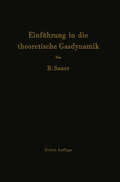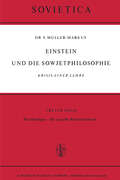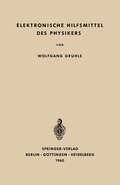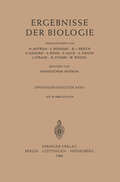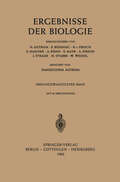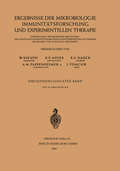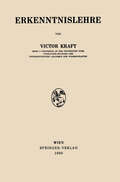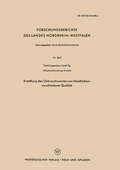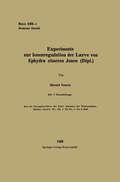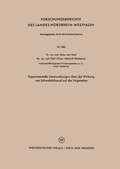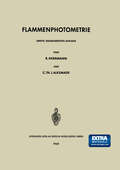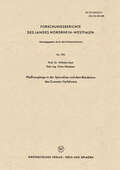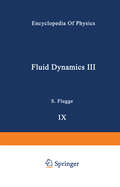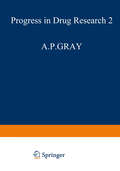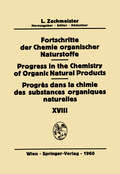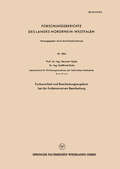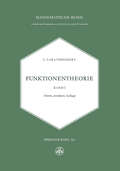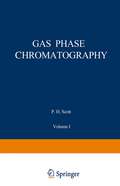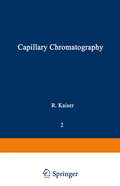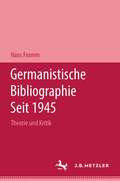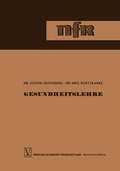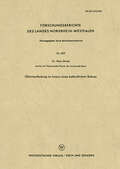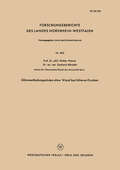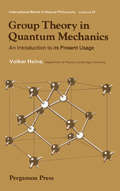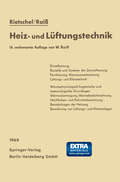- Table View
- List View
Einstein und Die Sowjetphilosophie: Krisis einer Lehre (Sovietica #5)
by S. Müller-MarkusDieses Buch soll ein Bericht über den Prozess Einstein sein. Es enthält das Material über die Diskussion um die Relativitätstheorie in der UdSSR seit 1950. Von 1951 bis 1955 wurde Einstein durch die offizielle Parteiphilosophie der UdSSR in den Anklagezustand versetzt. Der Prozess gipfelte in der Aufforderung, die Relativitätstheorie zu verwerfen und durch eine materialistische 'Theorie schneller Bewegungen' zu ersetzen. Selbst der Name 'Relativitätstheorie' sollte aus den physikalischen Lehrbüchern verschwinden. Die Anklage wurde vertreten von der ideologischen Führungsschicht der gewaltigsten irdischen Macht unseres Zeitalters. Der Angeklagte, in der Reife seines Lebens vor die vehementesten Angriffe gestellt, kam nur durch sein Werk zu Wort. Dies genügte jedoch, dass sich unter den sowjetischen Physikern und Philosophen noch zur Zeit Stalins mannhafte Stimmen der Verteidigung fanden. 1955 wurde der Prozess mit der offiziellen Anerkennung der Relativitäts theorie durch die Parteiphilosophie abgeschlossen. Es war ein Sieg der Wahrheit über die Gewalt. Die Folgen mussten das Ansehen der kommunistischen Ideologie erschüttern. Es hatte sich herausgestellt, dass zwischen der angeblich einzig wissenschaftlichen Philosophie und der exaktesten Naturwissen schaft, der Physik, ein Abgrund klafft, den zu überbrücken die Sowjet philosophie bis heute bemüht ist. Andererseits begannen die sowjetischen Physiker, wachgerufen durch die Appelle der Philosophen, ihr eigenes Weltbild mit adäquaten Methoden zu durchdenken. Diese ganze Ent wicklung ist von hohem Wert für eine Diagnose der geistigen Struktur der Sowjetgesellschaft.
Ergebnisse der Biologie: Zweiundzwanzigster Band (Ergebnisse der Biologie Advances in Biology #22)
by Hansjochem Autrum E. Bünning K. v. Frisch E. Hadorn A. Kühn E. Mayr A. Pirson J. Straub H. Stubbe W. WeidelErgebnisse der Biologie (Ergebnisse der Biologie Advances in Biology #23)
by H. Autrum E. Bünning K. von Frisch E. Hadron A. Kühn E. Mayr A. Pirson J. Straub H. Weidel H. StubbeErgebnisse der Mikrobiologie Immunitätsforschung und Experimentellen Therapie: Fortsetzung der Ergebnisse der Hygiene Bakteriologie.Immunitätsforschung und Experimentellen Therapie (pdf) (Current Topics in Microbiology and Immunology #33)
by W. Kikuth J. Tomcsik K. F. Meyer E. G. Nauck A. M. PappenheimerErmittlung des Gebrauchswertes von Handtüchern verschiedener Qualität (Forschungsberichte des Landes Nordrhein-Westfalen #865)
by Josef IlgExperimente zur Ionenregulation der Larve von Ephydra cinerea Jones (Sitzungsberichte der Österreichischen Akademie der Wissenschaften)
by Harald NemenzExperimentelle Untersuchungen über die Wirkung von Schwefeldioxyd auf die Vegetation (Forschungsberichte des Landes Nordrhein-Westfalen #884)
by Hans ˜vanœ HautFlammenphotometrie
by Roland Herrmann Cornelis T.J. Alkemade1. Prinzip der Methode und Begriffsbestimmung Bringt man in eine Bunsenflamme gewisse Metallsalze, z. B. Kochsalz, so verursacht die verdampfende Substanz in der Flamme ein deutliches, im gewählten Beispiel intensiv gelbes Leuchten. Andere Salze geben der Flamme andere Farben, z. B. färben die Salze von Strontium und Lithium die Flamme karminrot, von Calcium ziegelrot, von Barium gelbgrün, von Kupfer smaragdgrün, von Kalium blauviolett, von Arsen, Antimon und Blei fahlblau bis fahlgrün usw. Diese Flammenfarben sind charakteristisch für gewisse Kationen~ mitunter auch für gewisse Verbindungen wie CuOH. Man verwendet diese Leuchterscheinungen daher oft als Hilfsmittel bei qualitativen chemischen Analysen. Beim gleich zeitigen Einbringen von mehreren Metallsalzen versagen allerdings diese einfachen Methoden, weil das Auge das Gemisch mehrerer Farben nicht trennen kann. Mitunter liegen auch die charakteristischen "Farben" in einem Spektralbereich, in dem das Auge nicht mehr empfindlich ist. Betrachtet man nun das von einer mehrfach gefärbten Flamme ausgehende Mischlicht im Spektroskop, so sieht man ganz bestimmte, für die einzelnen Elemente bzw. Verbindungen charakteristische Spektrallinien bzw. Banden (Anhäufung von Linien s. unten). Anhand von Spektrallinientafeln oder Tabellen kann man einige qualitative Aussagen über die Zusammensetzung der in die Flamme hineingebrachten Stoffe machen. Über diese genügend bekannten quali tativen Verfahren soll hier nicht weiter gesprochen werden. Sorgt man nun durch geeignete Maßnahmen dafür, daß die Flamme über längere Zeit konstant brennt, und daß die Substanzzufuhr zur Flamme ebenfalls konstant bleibt, so ist die Intensität dieser beobachteten Spektrallinien bzw. Banden, der zum Leuchten gebrachten Elemente ein Maß für deren Konzentration.
Fließvorgänge in der Spinndüse und dem Blaukonus des Cuoxam-Verfahrens (Forschungsberichte des Landes Nordrhein-Westfalen #790)
by Wilhelm KastFluid Dynamics / Strömungsmechanik (Handbuch der Physik Encyclopedia of Physics #3 / 9)
by C. A. TruesdellSect 2. 317 tinuity surfaces 1. This suggests that a wake pressure Pw be associated with each flow past a bluff body, and that a wake parameter (2. 4) which plays the same role as the cavitation parameter (2. 1), be defined for the flow. This idea has been made the basis of a modified wake theory (ef. Sect. 11) which proves to be in good qu- titative agreement with pressure and drag measurements. It should be emphasized, however, that un h like the cavitation number, the wake parameter is a quantity which is not known a priori, and must be empirically determined in each case. (3) Jet flows. The problem of jet efflux from an orifice is one of the oldest in hydrodynamics and the first to be treated by Fig. 3a. the HELMHOLTZ free streamline theory. Of particular importance for engineering applications is the discharge coefficient Cd' which is defined in terms of the discharge Q per unit time, the pressure P, and the cross-sectional area A of the orifice, by the formula, (2. 5) where e is the fluid density. Two methods of measuring Cd have been most fre quently adopted. In the first the liquid issues from an orifice in a large vessel under the influence of gravity _,-____________ . , (Fig. 3 a), while in the second it 1 L is forced out of a nozzle or pipe under high pressure (Fig. 3 b).
Fortschritte der Arzneimittelforschung / Progress in Drug Research / Progrès des recherches pharmaceutiques (Progress in Drug Research #2)
by JUCKERFortschritte der Chemie organischer Naturstoffe / Progress in the Chemistry of Organic Natural Products / Progrés Dans la Chimie des Substances Organiques Naturelles (Fortschritte der Chemie organischer Naturstoffe Progress in the Chemistry of Organic Natural Products #18)
by P. W. Brian H. Brockmann J. F. Grove M. Heidelberger A. Kjaer J. Macmillan M. Pailer J. Roche N. Van Thoai O. Völker J. W. Williams L. ZechmeisterFunkenarbeit und Bearbeitungsergebnis bei der funkenerosiven Bearbeitung (Forschungsberichte des Landes Nordrhein-Westfalen #864)
by Herwart OpitzFunktionentheorie (Lehrbücher und Monographien aus dem Gebiete der exakten Wissenschaften #8)
by C. CaratheodoryGas Phase Chromatography: Volume I: Gas Chromatography
by Rudolf KaiserTHE present volume, which is the first of a three-volume work on gas phase chromatography, deals with the problems of gas chromatography in packed columns. Gas chromatography, like any other analytical method, is mainly a matter of practical skill, and therefore emphasis has been given to the apparatus at the expense of a more detailed presentation of the theory. The aim of this book is to make lecturers and students, chemists, works engineers and laboratory workers familiar with this highly effective branch of analytical physical chemistry. I hope too that the experienced worker may find references which will be of value to him in his work and which will spare him part of the now almost impossible task of keeping up to date with the literature. The nomenclature used here is the result of a number of discussions with Professor E. Cremer and Dr. E. Bayer, and I should like to take this opportunity of expressing my grateful thanks to them. The present book is based partly on my book Gas Chromatography which appeared at the end of 1959. Numerous discussions with Professor E. Leibnitz and his colleagues H. P. Angele, M. Hofmann, H. Holzhauser, M. Kuhl and H. G. Struppe and the experimental work carried out with them have all influenced this revision. I should also like to thank Dr. H. Kienitz and his colleagues Dr. K. Dorfner, Dr. H. D. Ermshaus and Dr. H. Runge for valuable suggestions.
Gas Phase Chromatography: Volume II: Capillary Chromatography
by Rudolf KaiserTHE remarkable capabilities of capillary gas partition chromatography (or, in short, capillary chromatography) are beyond all doubt. In spite of this, difficulties are continually arising in the experimental realization of this interesting development of gas chromatography, and this hinders the rapid acceptance of these methods. For this reason, in the present work I have dealt with experimental and practical problems rather than with theoretical aspects, hoping that this may serve to remove many of the problems con cerned. The present publication is based on experimental work carried out in productive collaboration with my teachers and colleagues, to whom I owe a great deal. I should like to thank the following for their valuable assistance and stimulating suggestions: Professor E. Cremer, Dr. H. Kienitz and his colleagues, Professor A. I. M. Keulemans, Dr. I. Halasz, and in particular Mr. D. H. Desty and Dr. R. P. W. Scott. I should also like to thank the management of the Badische Anilin- und Sodafabrik AG, Ludwigshafen, for their generous support and for per mission to publish this book. The outstanding co-operation of the Verlag Bibliographisches Institut, Mannheim, was for me a particular pleasure.
Glimmentladung im Innern eines kathodischen Rohres (Forschungsberichte des Landes Nordrhein-Westfalen #829)
by Hans StrackGlimmentladungssäulen ohne Wand bei höheren Drucken (Forschungsberichte des Landes Nordrhein-Westfalen #853)
by Walter WeizelGroup Theory in Quantum Mechanics: An Introduction to Its Present Usage
by Volker HeineGroup Theory in Quantum Mechanics: An Introduction to its Present Usage introduces the reader to the three main uses of group theory in quantum mechanics: to label energy levels and the corresponding eigenstates; to discuss qualitatively the splitting of energy levels as one starts from an approximate Hamiltonian and adds correction terms; and to aid in the evaluation of matrix elements of all kinds, and in particular to provide general selection rules for the non-zero ones. The theme is to show how all this is achieved by considering the symmetry properties of the Hamiltonian and the way in which these symmetries are reflected in the wave functions. This book is comprised of eight chapters and begins with an overview of the necessary mathematical concepts, including representations and vector spaces and their relevance to quantum mechanics. The uses of symmetry properties and mathematical expression of symmetry operations are also outlined, along with symmetry transformations of the Hamiltonian. The next chapter describes the three uses of group theory, with particular reference to the theory of atomic energy levels and transitions. The following chapters deal with the theory of free atoms and ions; representations of finite groups; the electronic structure and vibrations of molecules; solid state physics; and relativistic quantum mechanics. Nuclear physics is also discussed, with emphasis on the isotopic spin formalism, nuclear forces, and the reactions that arise when the nuclei take part in time-dependent processes. This monograph will be of interest to physicists and mathematicians.
